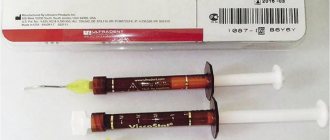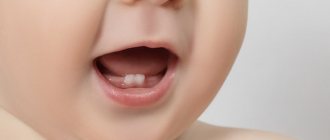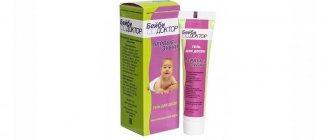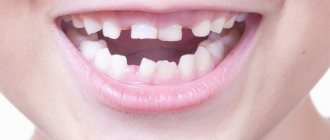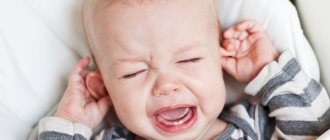Teething order
Is your baby about to turn 6 months old and are you noticing some anxiety in his behavior? This is natural, because the time of teething comes. And this is a difficult period in a child’s life.
The timing of teething in children can vary widely. Normally, the first teeth begin to appear closer to 6 months.
But it happens that baby teeth erupt earlier or much later. And there is nothing terrible here; this process is associated with the constitutional characteristics of the child.
- If you follow the pattern of teething in children, the central incisors on the lower jaw appear first. This usually occurs at 6-10 months.
- The upper central incisors appear at 8-12 months, and the first molars at 13-19 months.
- The canines “wake up” last – by 16-22 months.
- By the age of 2, a child usually already has 20 teeth, and from 6 to 12 years, baby teeth are gradually replaced by permanent teeth.
- Wisdom teeth do not have a milky version and appear in late adolescence.
"Dormikind" for children
Instructions Where to buy Dormikind
Dormikind improves the process of falling asleep and regulates sleep quality (maintaining the sequence of sleep phases, depth of sleep, duration) for the child’s natural activity without daytime sleepiness
Studies have found: Dormikind is comparable in effectiveness in children
- up to 1 year
- from 1 year to 3 years
- from 3 years to 6 years
Dormikind - for any degree of sleep disorders, which manifest themselves as:
- Restless sleep
- Disruption of the circadian rhythm of sleep, the child confuses day with night
- Irritability
- Anxiety, moodiness
- Tearfulness
- Frequent awakenings at night
- Staying awake for long periods of time at night
- Nightmares
Dormikind - for difficulties falling asleep:
- Falling asleep while feeding
- The need for rocking in arms or in a crib
- Sleep onset in parents' bed
- Refusal to sleep in a separate bed
Dormikind can help a child from birth to 6 years:
- The formation of a child's regime
- Gradual weaning of the baby
- Weaning a child off a pacifier/pacifier
- Birth of the next child
- Travel or relocation
- Visiting relatives
- The appearance of the nanny
- Visiting a kindergarten, sports section or creativity club
Dormikind is available in an economical form of 150 tablets. Dormikind is stored for 5 years. 1 package of Domikind means 37 days of use according to the instructions.
Links to sources:
- https://dl.com.ua/uploads/files/2014/8%20(37)/58380712.pdf
- https://www.mediasphera.ru/issues/zhurnal-nevrologii-i-psikhiatrii-im-ss-korsakova-2/2019/7/1199772982019072025/annotation
- https://remedium-nn.ru/?id=7693&download=1
- Miek C. Jong, Lydia Ilyenko, Irina Kholodova, Cynthia Verwer, Julia Burkart, Stephan Weber, Thomas Keller, Petra Klement A Comparative Randomized Controlled Clinical Trial on the Effectiveness, Safety, and Tolerance of a Homeopathic Medicinal Product in Children with Sleep Disorders and Restlessness. Evidence-Based Complementary and Alternative Medicine / 2016 Article ID 9539030, 11 pages, 2016. https://doi.org/10.1155/2016/9539030
- Khachatryan L. G., Pogorelova M. S., Geppe N. A., Lemeshko I. D., Kasanave E. V., Frolkova E. V., Trepilets V. M. Problems of sleep disturbances in young children: issues diagnostics and correction. Journal of Neurology and Psychiatry. S.S. Korsakov. Special issues. 2019;119(7-2):25-32. https://doi.org/10.17116/jnevro201911907225
- Sukhonosova O. Yu., Molochek N. V. Experiment in correcting the symptoms of increased irritability and sleep disturbances in young children. Pediatrics, Obstetrics and Gynecology no. 2, 2009
Teeth from birth? It happens
In exceptional cases, children are born with teeth. As a rule, we are talking about the lower incisors. They are called (neo)natal teeth. They erupt within 30 days. Their root is mobile, not formed, and often such teeth quickly fall out.
This feature is fixed genetically - as a rule, the parents had the same thing, a characteristic picture is observed in the baby’s brothers and sisters. Doctors suggest removing such teeth to prevent them from entering the respiratory tract. But this is not a mandatory procedure, at the discretion of the parents.
Teething symptoms
The appearance of teeth causes some discomfort in children, which affects their behavior and general condition. In the support chat for the online course “For Every Mom,” we will look in more detail at the main symptoms and means of helping the child and mother. May this period pass as calmly as possible for you.
Teething has accompanying symptoms that will help you understand the cause of these changes:
- Salivation
- Irritation and rash around the mouth
- Change in stool (usually loosening)
- Runny nose
- Temperature increase
- Anxiety
- Moodiness
- Sleep disturbance
This process is not fast. Discomfort may occur several days before gum eruption. If this stage is delayed, they speak of difficult eruption.
There is no reliable information about why the temperature rises during teething in children. It can be assumed that this is a preventive protective reaction of the body. After all, as a result of teething, a tooth creates a wound in the gum, and the body proactively turns on a protective mechanism in the form of inflammation and an increase in temperature. This is necessary to prevent infection of the wound surface...
How to choose a teething remedy
The eruption of baby teeth is a physiological process that usually begins around 4-6 months of a child’s life and ends at about two and a half years. Regularly occurring symptoms of teething: restlessness (especially at night), increased salivation, itching, swelling and soreness of the gums. Any mother, naturally, wants to make this period of development easier for the child, relieve pain in the gums, and reduce the likelihood of sleepless nights. Therefore, mothers very often ask doctors questions: what to do when teething and how to help the child?
There are several solution options with their advantages and disadvantages:
1. Homeopathic remedies.
On the one hand, ingestion of diluted chamomile and other herbal ingredients will calm the baby, however, from the point of view of scientific medicine, they are unlikely to have any direct effect on the gums.
| 2. Systemic pain relievers (eg paracetamol, ibuprofen) They are safer, but they will also act on the baby’s body in general, and not on the gums. 3. Gels based on lidocaine or benzocaine These are local anesthetics that have an analgesic effect during teething. But there are several nuances: • Firstly, with frequent use, lidocaine and benzocaine can have a toxic effect on the body of a small child. In 2014, the US Food and Drug Administration (FDA) reported 22 cases of severe adverse events to 2% lidocaine gels in children under 3 years of age. Side effects of lidocaine included respiratory distress, decreased heart rate, decreased blood pressure, and convulsions. That is why the Department has imposed a ban on gels with high levels of it. • Secondly, age restrictions: usually from 3 or 6 months. If your baby starts teething early, these medications will not help him. In addition, such gels can have a very specific taste, and the baby may completely refuse to use it again. |
4. Gels based on natural extracts without synthetic anesthetics
These gels are based on extracts that have anti-inflammatory, analgesic and antiseptic effects.
For example, the new Italian gel for gums Dentinale® natura with herbal ingredients: aloe vera juice, boswellia and chamomile extracts, will help postpone the teething period without resorting to analgesics and anesthetics.
Dentinale® natura has a mild anti-inflammatory and antiseptic effect. The gel does not contain :
• synthetic painkillers
• sugar
• parabens
It is almost impossible to overdose on such a drug, it is harmless if swallowed, side effects are not described and theoretically can only be associated with individual intolerance to the components of the gel.
Pleasant to the taste and has no age restrictions.
Easy teething and good nights!
PRODUCTS BY THEME: Dentinale
You can read the reviews at the link: https://www.babyblog.ru/td/itog/41
How to make teething easier
- First of all, it is necessary to remain calm and reassure the child that everything is under control and soon his suffering will end.
- Teething is accompanied by itching in the gums, which forces the child to chew on any hard objects. Provide him with clean and safe teethers - special rings, toys, rags.
- Cold significantly relieves pain and itching in the inflamed gums. You can pre-cool the teether in the freezer, apply ice wrapped in a cloth or bandage for a short time.
In medicine, during teething, special gels are actively used, which are applied to the gums at the site of inflammation: “Cholisal”, “Dentinox”, “Kalgel”... All of them have a local anesthetic effect. And any anesthesia has a detrimental effect on the body, suppressing its defenses.
However, you can ease your child’s suffering while strengthening his immunity. Homeopathy will help you with this. This method is very effective and safe for the baby.
Chamomilla
- A child in the Hamomilla state is capricious and irritable. He kicks, bites, fights, asks to be carried.
- He may demand one toy or another, but having received what he wants, he instantly loses interest in it and throws it away. Malaise is accompanied by outbursts of anger.
- The condition worsens at night, better from motion sickness (in the car, in a stroller). Strong-smelling, green, lumpy stools. A characteristic detail is that one cheek may be red and the other pale. The head sweats profusely, the sweat is hot.
Calcarea carbonica
- Children of this type are well-fed, chubby, but have flabby muscles. During sleep, the Calcarea child's head sweats, especially the back of the head. Sweat has a sour smell.
- These are children with late teething; the teething process itself is long. Such disorders are associated with calcium deficiency, which is poorly absorbed in this constitution.
- Tendency to frequent colds and ear infections. A passionate desire for eggs (especially soft-boiled ones), cheese and milk, as well as sweets is a sure sign of a calcareous child.
- He is worse in cold damp weather, better in warmth.
Homeopathy for babies
Medicines for Infants Dosage: Take 4 -5 granules three or four times a day or, if the pain is very severe, at intervals of half an hour to an hour. If the patient's condition improves, reduce the frequency of dosing: stop taking the medicine when a reliable improvement in the condition is achieved.
| Medicine | Specific indications | Main symptoms | Worse | Better |
| Aconitum narellus Cold | The initial stages of a cold A cold quickly localizes in the chest Sharp sounds when breathing | Sudden onset of symptoms Illness begins after exposure to cold, dry wind | At night In a warm room From lying on the sore side | Outdoors |
| Croup | Hoarse, dry cough Loud, labored breathing Holding the throat when coughing | Motor restlessness! Anxiety, fear | ||
| Diarrhea | Watery stools. Child cries: insomnia. exhibits motor restlessness | |||
| Ear infections | Outer ear swollen, hot, red, painful | |||
| Vomit | From nervous shock or fear Profuse sweating Frequent urination | |||
| Arsenicum album Diarrhea | From spoiled food From excessive consumption of fruit Frequent, dark-colored stools with a foul odor After eating and drinking | Anxiety Weakness Thirst quenched by small sips of water Burning pain | On the right side of the body After midnight From eating and drinking From cold On the sea coast | From the heat From warm drinks |
| Vomit | From spoiled food From excess fruit in the diet After eating and drinking Nausea | |||
| Belladonna atmountain Cold | Sudden strong onset Restlessness Red face, hot and dry skin Feverish state | In the afternoon | In a half-bent position | |
| Ear infection | For a cold head or a wet head Usually the right ear | Red eyes, increased sensitivity to light: pupils are dilated Pulse is firm, strong and rapid | In a lying position From touch From shocks and shaking From noise | |
| Teething | Irritable Delusional state; may bite or hit | |||
| Angina | Throat bright red | |||
| Vomit | From fear From nervousness | |||
| Bryonia alba Cold | Dry and stuffy nose Dry lips Harsh dry cough | Wants to be left alone Irritability; demands something with screams and tears, then refuses what is demanded | ||
| Colic | Worse from motion and heat | Thirst with desire to drink in large quantities | From any movement or movement From touch From heat | In peace In silence |
| Vomit | From fatty foods From high-calorie foods | Constipation with hard to dry stools | ||
| Сalcarea carbonica Colic Teething | Milk intolerance Late teething Poor absorption of calcium by the body | Milk intolerance “Light” complexion, plump Sweating of the head; fontanelles heal late | From any cold or chill From physical or mental stress From wet weather | From lying on your sore side From dry weather |
| Calcarea phosphorica Teething | Late teething | Dark hair and eyes, thin build; fontanelles close late | From damp, cold weather From melting snow | In summer In warm dry weather |
| Calendula officinalis (lotion)For minor cuts and scrapes | Relieves pain Accelerates healing | |||
| For diaper dermatitis | Reduces pain Accelerates healing | |||
| Chamomilla vulgaris Colic | Pulls the legs up towards the stomach. Bloating. | Wants to be carried in arms all the time; one cheek is red, the other is pale. | At night From the heat In the fresh air | When held by adults |
| Diarrhea | Greenish, sticky, mucous stool during teething | Irritability, asks for something, and when he receives it, throws it away | Out of anger | From warm wet weather |
| Ear infections | Very severe pain; the child is beside himself in pain | Insomnia in the presence of drowsiness | ||
| Teething | Irritability Insomnia despite extreme fatigue Diarrhea with greenish stools | |||
| Colocynthis Colic | He doubles over in pain, pulls his legs towards his stomach, presses on his stomach | Abdominal bloating Irritability | From anger From eating or drinking even in minimal quantities | In a double-bent position From heat From firm pressure |
| Diarrhea | Stool resembles jelly Severe cramps A piece of food causes an attack of diarrhea | |||
| Dulcamara Diarrhea | Severe cramps Diarrhea occurs immediately after eating Stools are watery, sticky, with blood, mucus, green in color | Diarrhea occurs after exposure to cold, damp weather Increased sensitivity to cold | At night In cold, damp weather | From external heat From constant movement |
| Ear infection | Stitching pain Buzzing in the ears | |||
| Ferrum phosphoricum Ear infection | Initial stages, before abscesses appear in the ears Throbbing pain | The disease occurs gradually High fever Pale face with red cheeks Anxiety Insomnia | On the right side From touch From movement From shock and shaking | From cold compresses |
| Gelsemium sempervirens Colds, flu | Apathy, detachment, indifference Eyes barely open, heaviness in the eyelids High temperature Chills running up and down the back Soft, vague pulse Lack of thirst Symptoms develop several days after exposure to the factors that caused the disease | At 10 a.m. In wet weather From excitement | In the fresh air From prolonged movement After excessive urination | |
| Hepar sulphuris Cold | Constant discharge Yellow discharge from one nostril Rough breathing Wet, gurgling cough | Sensitivity to drafts Irritability Sweating | In dry cold weather | And damp weather From the heat After eating |
| Ear infection | Stitching pain radiating from throat to ears | |||
| Angina | Stitching pain radiating from throat to ears | |||
| Ipecacuanha Vomiting | After eating Uncontrollable vomiting | Tongue without plaque, clean Constant nausea | From the moist warm wind In a lying position | |
| Magnesia phosphorica Ear pain | Severe neuralgic pain | On the right side of the body From cold At night | From the ashes From the pressure | |
| Mercurius solubilis Cold | Accompanied by diarrhea | More intense salivation than usual Sweating Unpleasant odor Weakness, trembling | At night In humid weather From sweating From lying on the right side In a warm room From the warmth of the bed | |
| Diarrhea | The stool is sticky, with blood, with mucus, greenish in color. A feeling of incomplete bowel movement. | |||
| Angina | Swelling of the cervical glands | |||
| Nux vomica Cold | Nose runs during the day Nasal congestion at night and in the open air | Irritable Belching | At 4 am after eating From touch | In the evening After continuous daytime sleep From firm pressure From humid weather |
| Constipation | Pushing with little result | |||
| Diarrhea | Appears as a result of overeating Strong attempts to defecate with no or little result | |||
| Phosphorus Vomiting | Thirst with desire for cold water, vomiting immediately; as soon as it warms up in the stomach | In the evening From touching From drinking From warm food | From the cold In the fresh air From cold food From sleep | |
| Podophillum peltatum Diarrhea | Occurs after bathing, eating or drinking Uncontrollable urge to defecate Diarrhea contains undigested food Watery | Early morning hot weather Teething | ||
| Pulsatilla nigricans Cold | Used for “mature” colds Thick, creamy discharge that does not irritate the skin of the face | Wants to be outdoors Craves attention Changeable mood Tearful | From the heat After eating | Outdoors From movement From cold applications |
| Constipation | Painful, swollen belly | There is no thirst | ||
| Diarrhea | From overeating Pushing with little or no results | |||
| Ear infection | The outer ear is swollen and red Thick, yellow discharge that does not irritate the skin: foul odor Pain worsened by warmth | |||
| Silicea terra Teething | Painful P0later | Irritability cannot tolerate interference in his affairs Sweaty feet, hands, head and neck Milk intolerance Thin delicate skin Thin sandy hair Lively and quick-witted | In the morning In a position lying on the left side In a lying position From washing From cold | From the warmth From wrapping your head in a blanket |
| Verbascum thapsus Ear infections | Usually in the left ear Decreased hearing | Left-handed remedy | From 9 am to 4 pm From the effort of bathing From temperature changes From talking From sneezing |
Share your interest!
Calcarea phosphorica
- A child in the state of Calcarea phosphorica is fussy, runs somewhere all the time, complains of boredom, whines. He wants to be entertained.
- The teeth of such children appear slowly and late, immediately grow bad and weak, and quickly decay.
- People of this type do not like drafts, they feel worse in the spring, better in dry, warm weather, lying down.
These are the main homeopathic remedies that are suitable for difficult and painful teething in babies. To learn to see the symptoms, understand the processes occurring during illness, be able to select remedies, create your own family homeopathic first aid kit and use it on occasion, we invite everyone to the video course on children’s health “For Every Mother”.
Go to video course
A hoarse voice is one of the signs of laryngitis in a child
14.09.2021
Laryngitis in a child is a common viral infection that tends to recur. This mainly applies to young children,
because a child's larynx is more susceptible to infection and swells more easily than an adult's larynx due to its location and anatomical
buildings. This is usually a minor illness, but in some cases severe acute laryngitis may develop, which may
be life-threatening. Learn about the symptoms of laryngitis in children and how it is treated.
Laryngitis in a child - causes
The disease is caused by viruses, most often: parainfluenza virus, influenza A or B virus, adenovirus, RS virus, metapneumovirus.
There are also cases of bacterial infections, for example, during complications after an untreated cold. As a consequence, there is
damage to the mucous membrane, swelling around the larynx and narrowing of the airway. The disease usually develops in the 1st and 4th quarters
year is a period of increased viral activity, worsening weather conditions and intense heating of apartments. Warm and dry air
promotes the development of infections.
Laryngitis is usually mild and associated with high fever, infection and breathing problems, but is not life-threatening.
The most common type is subglottic laryngitis. It should not be confused with acute diphtheria laryngitis caused by the diphtheria bacillus.
However, life-threatening conditions may include: acute laryngitis and epiglottitis, which are manifested by a large tumor that interferes with breathing.
Why is this happening? Sensitive larynx in a child
Laryngitis and severe complications occur in young children because their airways are slightly different from those of adults.
The submucosa of the larynx in children is looser and contains many blood and lymphatic vessels , which makes it more prone to edema ;
the socket of the larynx is located much higher, the larynx is smaller, the epiglottis is flaccid, and the immune system is not yet formed. All this is done by the larynx in children
vulnerable to infections.
Laryngitis in a child - symptoms
Subglottic laryngitis in children occurs between 5 and 6 months of age, with the greatest incidence in the second year of life. Boys are more likely to get it
type of infection than girls, and affects about 6-8% of children under 5 years of age each year.
Symptoms of laryngitis in children appear suddenly and are preceded by several days of respiratory infections. Most often occurs at night or in the morning, and
symptoms may vary in severity, from mild inflammation, including an intermittent barking cough and hoarseness, to severe inflammation,
requiring emergency assistance.
Symptoms:
• The so-called stridor is a high-pitched sound when breathing due to a narrowing of the airway. • Characteristic barking cough. • Hoarseness. • Rude voice, even silence. • Mild to moderate shortness of breath. • Possible slight fever.
Acute symptoms of subglottic laryngitis:
• Severe shortness of breath, accompanied by increased work of the pectoral muscles. • Blue skin color. • Anxiety. • Impaired consciousness. • Breathing problems.
Narrowing of the airway in the subglottic region can quickly increase and cause severe shortness of breath, so should not be underestimated
infection, but appropriate treatment must be provided as soon as possible. The disease varies in intensity, and the symptoms of laryngitis
in children, initially harmless, can quickly worsen and cause respiratory failure.
Laryngitis in a child - treatment at home
Although the symptoms of laryngitis in children can be worrying, most cases are mild and can be treated well with
using home remedies. What will be effective for childhood laryngitis? Care should be taken to create an atmosphere of calm, because nervousness and
tension will increase the child's fear, which - based on the vicious circle effect - will increase shortness of breath and respiratory failure. To prevent
increased shortness of breath, it is useful to inhale cold, moist air, which reduces swelling of the larynx. It is recommended to open the window wide or remove
take the child to the terrace/balcony and let him breathe in the fresh, cool air. You should remember to dress your baby correctly so as not to catch a cold.
Another way to treat mild laryngitis in a child is to inhale saline and drink drinks. After the attack
shortness of breath stops, you should contact your pediatrician for effective treatment for laryngitis. The doctor knows best what to use to treat the larynx
child and what treatment will be most effective in each case. He will likely prescribe corticosteroids or other medications
to reduce swelling of the larynx.
Published in Pediatrics Premium Clinic

